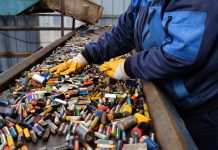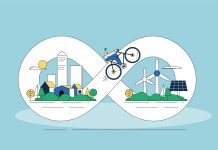The EU has been a pioneer in green technologies for decades, but China is rapidly catching up in eco-innovation, explains Prof Dr Raimund Bleischwitz
The EU has been a proud pioneer in green technologies since the 1970s. International milestones such as the Paris Agreement on Climate Change signed in 2015 confirm leadership and ambitions. Yet, the EU has recently been crippled following concerns over migration and struggles with the state of the union itself – absorbed by managing Brexit and sweeping populism. As a result, the EU’s pioneering spirit in environmental action seems to vanish, and forces of fragmentation appear stronger than attempts for integration. So, what’s the evidence of green shifts and what trends may come up?
One needs to look at the wider picture of societal transitions to grasp the fundamental uncertainties and the ubiquitous ‘age of anger’ (Mishra Pankaj). Others call it a ‘productivity puzzle’ – a quest for the wellsprings of prosperity. For decades, if not centuries, labour has been the main driving force. The engine of growth based on labour has been stuttering in many countries, and the future challenges of Industry 4.0 – name it digitalisation and artificial intelligence – is likely to accelerate crisis.
The troubled state of the environment with tonnes of plastics polluting oceans and sea animals, historic droughts and other extreme weather events, call for a restart in efforts to think through productivity and prosperity. For a turnaround, societies will need to reconsider productivity and move towards a circular economy (CE), one that creates public values through unleashing resource productivity. Fortunately, the Europeans are not alone any longer.
The hubs of innovation and change are shifting eastwards. China, Japan and South Korea have strong national strategies for enabling a circular economy and low carbon societies. After more than 15 years of being a frontrunner, the new Chinese policies enacted in 2017 introduce product redesign and the sharing economy, with value creation opportunities particularly for cities. Large-scale industrial parks such as Liuzhou and Kawasaki in Japan demonstrate radical emission reductions and cost savings through principles of industrial ecology and cascading energy use. New lighthouse projects such as Lingang City and its Low Carbon College, located close to Shanghai Disneyland to attract millions of visitors in the future, start to act as living laboratories for the next great transformation – towards a circular economy.
Collaboration across movers and scalers, not confrontation
Geography and scale matter, as much as new modes of collaboration. The idea of a ‘first mover’ is often associated with a personality or a firm unleashing a Schumpeterian dynamic of overcoming barriers towards becoming a champion; national systems of innovation would underpin such efforts. The innovation systems of the 21st century may look different. The new normal cuts across nation states. International collaborations may well be embedded in regional action across multiple stakeholders to test and integrate novel products into systems of provision – the electric vehicles in Chinese cities being a splendid example.
Yet, such case also demonstrates how transformation spreads from developing key technologies and testing new systems towards ‘first scalers’ in mass markets: green transitions are spanning continents and involve producers, consumers, and governments. China now constitutes 60% of all new electric cars in the world, and some observers expect a ban for gasoline cars as early as in 2022 – quite a disruptive shift and a nudge for Europeans as well as for industries to stay alert as second movers. Mission-oriented policies (Mariana Mazzucato) ought to be developed. Imagine a mobility being independent of oil in the year 2030, what a different world it would be.
No doubt, there will be winners and losers. However, the savings on purchasing and processing costs for energy, materials and water as well as on total costs to access are enormous, compared to returns on old-fashioned investments and linear business models. Estimates done by the Ellen MacArthur Foundation count such savings equivalent to around 14% and 16% of China’s projected GDP in 2030 and 2040, which altogether could enable more Chinese urban dwellers to enjoy a middle-class lifestyle with low environmental impacts. European findings give evidence for double-digit cost savings in manufacturing outweighing efforts in change and enabling investments into new products and services to the benefit of the people.
Key enablers are within the built environment and access to affordable housing, mobility and food, hence in line with key SDGs. New collaborations can bring along new and refurbished buildings following a modular and multi-functional design, with components being ready for reuse and digitally enabled sharing models. In energy, food and water, cities could become regenerative and recover nutrients for urban farming. Universities, labelled as ‘one of the greatest institutional inventions of the past millennium’ (Andy Haldane) have a particular role to play as providers of knowledge and social skills as well as facilitators for life-long learning across cultures. Blending traditional silos of knowledge and skills with grand challenges, novel solutions and upscaling them will be key in going beyond CO2 reduction towards addressing resource interlinkages (the ‘nexus’) in a more holistic manner towards a circular economy and systemic eco-innovation.
A green alliance between China and Europe
The China – EU agreement on a circular economy signed in 2018 has been a useful step in the right direction; we propose six actions for the way ahead:
1) Collaborations among cities and industrial parks, to include low carbon energy systems, circular buildings with recovery options for materials, shared zero-emission vehicles, and urban nexus innovations such as Alibaba’s JuTuDi and working with circular economy utilities such as Veolia.
2) Ambitious CE standards for key product groups in construction, mobility and food that enhance affordability and sharing.
3) A regional Platform for information and better policy, combined with an action clearinghouse on CE initiatives, technology, and know-how transfer in order to practice what is preached.
4) Redesigning the ‘one belt, one road’ initiative towards a green EurAsia platform, with extended producer responsibility schemes, green supply chains, and creative solutions for the fossil fuel economies of Central Asia and for eco-innovations in Eastern Europe.
5) Coordinated market-based incentives towards removing harmful subsidies, transforming the ‘zombie industries’ of cement and steel, and unleashing investments into CE and public values.
6) A Foresight Commission assessing pathways and options towards 2030 and beyond, with scenarios and modelling interacting with planning and stakeholders.
The years ahead will look brighter if opportunities of collaborations are being grasped and if people realise they benefit from tangible innovations on the ground and participate in change rather than feeling left behind.
Raimund Bleischwitz
Prof Dr, Director
University College London, Bartlett School
of Environment, Energy and Resources
(UCL BSEER)
inno4sd board member
Global Fellow
Smart Prosperity Institute
Tel: +44 20 3108 9207
r.bleischwitz@ucl.ac.uk
https://iris.ucl.ac.uk/iris/browse/profile?upi=RBLEI92
www.twitter.com/BleischwitzR
This publication has benefitted from funding from the European Union’s Horizon 2020 Research and Innovation Programme under grant agreement No. 641974. (Green.eu./Inno4SD.net)
*Please note: this is a commercial profile











